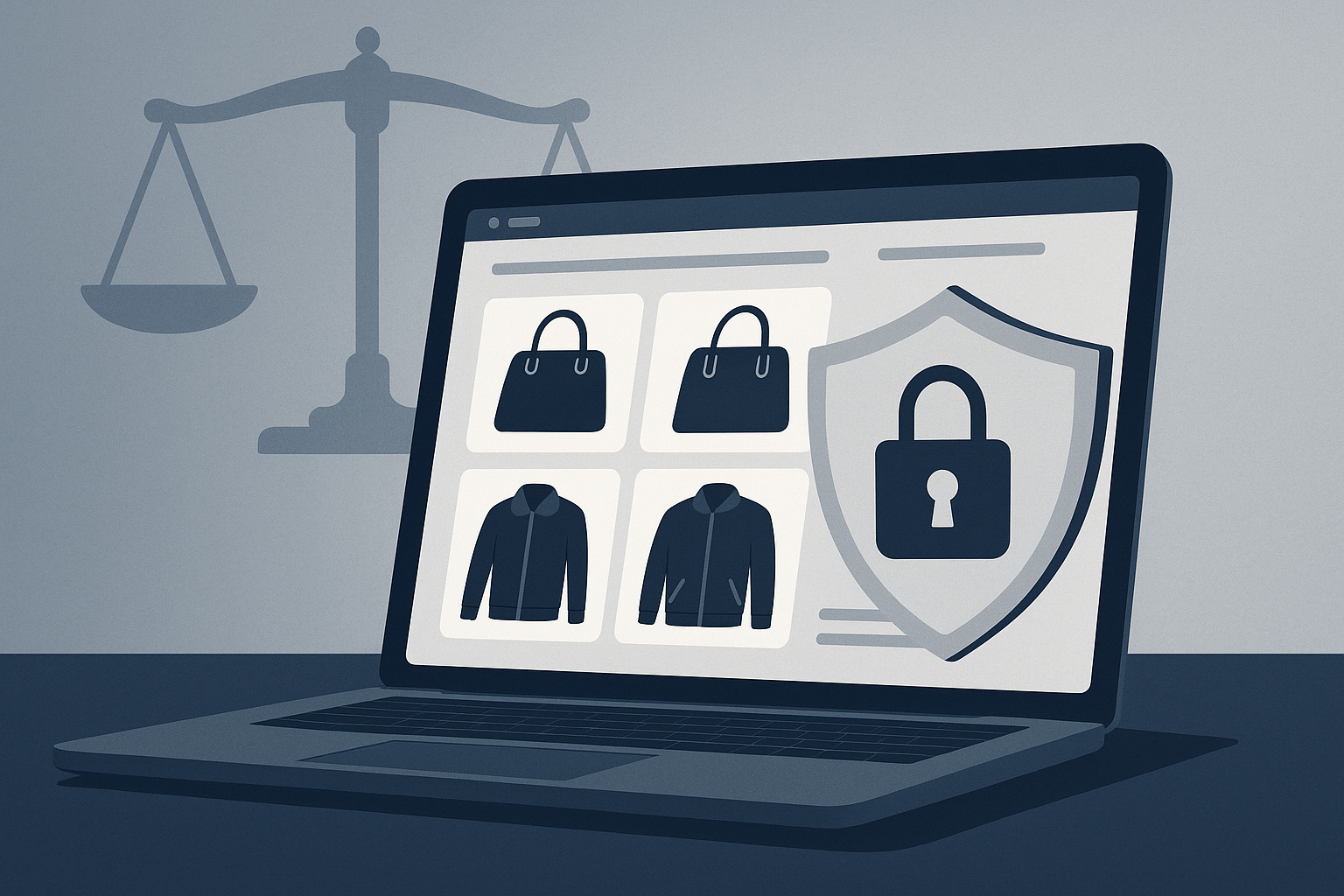E-commerce has transformed how South Africans buy and sell goods. Platforms that connect small sellers with buyers have democratised retail and given entrepreneurs access to nationwide audiences. But these platforms also face a persistent risk: counterfeit goods.
Recently, BrandLaw represented a foreign-based online marketplace, operating in South Africa, accused by luxury and outdoor brands of “aiding and abetting” the sale of counterfeit products on its platform. The case raised complex questions about the scope of liability under the Counterfeit Goods Act, the Trade Marks Act and South African common law. It also tested the boundaries between local law and international doctrines of “contributory infringement.”
This article sets out the challenge, the legal issues and the strategy we developed to protect our client – while also fostering practical cooperation with brand owners.
The challenge
Our client, a South African online marketplace, allows independent sellers to list and sell goods to consumers nationwide. It does not own stock, set prices, or advertise goods itself. Like global platforms such as eBay or Etsy, it provides the digital infrastructure for trade.
Two sets of well-known brand owners – a global luxury fashion house and a global outdoor gear company – alleged that counterfeit versions of their products were appearing on the platform.
They accused the platform of:
-
Direct infringement: claiming that hosting listings amounted to “selling” or “offering for sale”;
-
Aiding and abetting infringement: by facilitating and benefiting from counterfeit sales; and
-
Failing to prevent counterfeits: despite being put on notice.
Both threatened litigation unless the platform changed its practices. One letter even warned that the platform’s stance would be “met with the contempt it deserves” – language that illustrates just how aggressive and intimidating enforcement demands can be when major rights holders confront such platforms.
The legal issues
1. The Counterfeit Goods Act
Section 2(1) of the Counterfeit Goods Act 37 of 1997 criminalises, among other things, manufacturing, possessing, selling, offering, exhibiting, distributing, or importing counterfeit goods.
Section 2(2)(a) adds liability if a person, at the time of the act or conduct, knew (or had reason to suspect) that the goods to which the act or conduct relates were counterfeit. Section 2(2)(b) extends liability where someone fails to take all reasonable steps to avoid infringing conduct.
The question was: does an online marketplace that merely hosts third-party listings fall within these prohibitions?
Our argument was straightforward:
-
The platform does not directly sell or possess goods and therefore cannot be deemed to be responsible for any infringing act or conduct at the time such conduct is performed by third parties within s 2(2)(a); and
-
Its liability, if any, depends on s 2(2)(b) – i.e. whether it failed to take “reasonable steps” to prevent infringing sales.
South African courts assess “reasonable steps” through the boni mores – the community’s moral convictions, reflecting society’s sense of justice, fairness and what is right or wrong. In Knop v Johannesburg City Council 1995 (1) SA 100 (A), the Appellate Division confirmed that wrongfulness must be tested against what society regards as reasonable, not perfection.
The standard of reasonableness must be evaluated on a case-by-case basis an ordinary, normal subject, bearing in mind the subject’s specific circumstances and such conduct must be “accepted as normal and general by other members of the community in similar circumstances”.
To test this in practice, we interviewed and canvassed the procedures of other leading South African e-commerce platforms, examining how they handle counterfeit risks. None engaged in blanket pre-screening; all relied on takedown notices, user reporting and cooperation with rights holders.
Against this backdrop, our client’s measures – clear takedown policies, repeat-offender bans and user education campaigns (which boosted counterfeit reporting by 350%) – were not only consistent with industry norms and thus comfortably met this reasonableness threshold, but demonstrably stronger.
2. Trade Marks Act and Common Law
Brand owners also relied on section 34(1) of the Trade Marks Act 194 of 1993, which prohibits unauthorised use of identical or confusingly similar marks in relation to goods or services.
They argued that even if the platform itself did not sell goods, it “aided and abetted” infringement by third-party sellers. This raised the question of secondary liability under South African law.
At common law, liability can extend beyond the primary wrongdoer. The classic formulation is that a person who “instigates, aids, abets, or authorises” another to commit a delict may also be liable (McKenzie v Van der Merwe 1917 AD 41; Esquire Electronics Ltd v Executive Video 1986 (2) SA 576 (A)). But both cases confirm that aiding and abetting requires instigation or active involvement – neutral facilitation is not enough.
South African courts have also emphasised the need for control and intent:
-
In Smith & Nephew v Mediplast Pharmaceutical Sales CC 1999 (2) SA 646 (D), the court held that a manufacturer that sold infringing goods to a retailer was not liable for subsequent resale by that retailer – because it no longer exercised control. Our client, which never touched or owned the goods, had less control than the parties in these cases and was therefore in an even more defensible position.
-
In Cipla Medpro (Pty) Ltd v Aventis Pharma SA [2013] ZASCA 122, the Supreme Court of Appeal confirmed that contributory liability arises only where a party actively instigates or directs the infringement. Negligence or general awareness is insufficient; dolus – intentional participation or intent to further the infringement – is required.
We also noted that under Capital Estate and General Agencies (Pty) Ltd v Holiday Inns Inc 1977 (2) SA 916 (A), passing-off requires a misrepresentation by the defendant itself. As a neutral intermediary, our client made no representations of its own.
3. International comparisons
The opposing parties invoked the US doctrine of contributory trade mark infringement, developed in Inwood Laboratories Inc v Ives Laboratories Inc 456 U.S. 844 (1982). Under Inwood, liability can attach to intermediaries who (a) know or have reason to know of infringement and (b) continue to supply services. Specifically, it established a test for contributory trademark infringement. The factors mentioned – (1) benefit from the infringing activity, (2) notice of the infringing activity, and (3) the right and ability to control the activities of the person committing the infringement – are typical considerations in U.S. jurisprudence which are, however, not native to South Africa precedent case law.
Nonetheless, we pointed out that this doctrine was tested in Tiffany (NJ) Inc v eBay Inc 600 F.3d 93 (2d Cir. 2010), where eBay was accused of facilitating sales of counterfeit Tiffany jewellery. The US Court of Appeals held that eBay was not liable merely due to a general awareness of counterfeits being sold on its platform, provided it acted on specific takedown notices and had reasonable anti-counterfeit policies, supporting our client’s position..
The EU Court of Justice in L’Oréal v eBay (2011) took a similar approach, focusing on whether platforms acted once notified.
While persuasive, these cases are not binding in South Africa. Our courts have developed their own approach, rooted in delict and the Lex Aquilia, requiring proof of intent and control. Importantly, even under the Tiffany case, liability only arises if platforms ignore specific notices (for example items flagged as counterfeit by brand owners). In our case, takedown logs showed that over 90% of flagged listings were removed within 24 hours, positioning our client’s conduct as compliant with international benchmarks.
4. Reasonableness in practice
Even if strict liability did not apply, could the platform be said to have failed to take “reasonable steps” (as required by s 2(2)(b) of the Counterfeit Goods Act)?
The test, again, is contextual. Courts consider industry practice, feasibility and fairness – not a utopian standard. We had already benchmarked our client’s conduct against other major South African platforms and confirmed that others did not engage in blanket automated pre-screening. They relied on takedown systems, user reporting and cooperation with rights holders.
On that evidence, our client’s measures – including repeat-offender bans and user education campaigns that boosted counterfeit reporting by 350% – were not only consistent with industry practice but, in several respects, stronger.
Our approach
BrandLaw developed a two-pronged strategy.
Legal defence
-
We emphasised the distinction between a platform and a retailer. Unlike a store that owns and advertises goods, our client had no direct role in sales.
-
We relied on precedent (Smith & Nephew, Cipla, Esquire, McKenzie) to show that liability requires control and intent – neither of which were present.
-
We rebutted attempts to import US contributory infringement doctrine wholesale into South African law, highlighting the stronger protection given to intermediaries here; and noting that even under Tiffany v eBay, liability does not arise from general awareness of counterfeits but only from ignoring specific notices of infringement.
-
We documented our client’s anti-counterfeit measures: clear Terms & Conditions prohibiting counterfeit goods, proactive scanning, prompt takedowns and banning of repeat offenders.
Practical engagement
At the same time, we recognised that litigation benefits no one and that amicable collaboration can lead to mutual beneficial win-win. We therefore proposed constructive cooperation with rights holders, including:
At the same time, we recognised that litigation benefits no one. The better course was to turn the dispute into an opportunity for constructive engagement. By focusing on practical solutions that addressed brand owners’ concerns while keeping the platform’s business model workable, we were able to propose amicable cooperation rather than confrontation. This included:
-
Training sessions: inviting brand holders to share guidance and tools with the platform’s staff, for example to assist identifying product categories they do not produce and providing brand-specific indicators of counterfeits, so that such listings can be more easily flagged and removed.
-
AI detection tools: suggesting that, with input from rights holders, future systems could be developed to help automatically flag suspect listings, if the necessary expertise and resources were made available.
-
User education campaigns – which had already increased counterfeit reporting by 350%.
-
Faster takedowns: with most counterfeit listings removed the same day they were flagged.
-
Direct cooperation: encouraging rights holders to liaise directly with the platform to share information and resolve issues practically, rather than through lawyers, thereby avoiding unnecessary escalation (often driven by firms who profit from litigation) and keeping the client’s business interests at the centre.
-
Aligned interests: stressing that both sides want the same outcome: customer trust in genuine goods, since counterfeits damage both brand value and the platform’s reputation.
This balance of robust legal defence and collaborative goodwill gave our client both legal protection and a stronger reputation as a responsible intermediary.
The outcome
Our client remained insulated from liability under South African law. The brand owners, while reserving rights, engaged with the constructive proposals and acknowledged improvements to monitoring.
The immediate threat of High Court litigation receded, replaced by a framework for cooperative enforcement. In practical terms, counterfeit takedown efficiency improved, sellers were better educated and trust in the platform was reinforced.
The outcome reflected the balance our courts have long aimed for: as in Knop, reasonableness is the measure, not perfection; and as in Cipla, liability cannot be extended without dolus.
Lessons for businesses
This case illustrates several important lessons for South African e-commerce operators:
-
Marketplaces are not automatically liable. Liability depends on knowledge, control and reasonable steps – not mere facilitation.
-
Reasonableness is contextual. Courts look at industry practice, feasibility and fairness, not perfection.
-
Case law matters. South African precedent requires dolus or control (Smith & Nephew, Cipla), unlike the broader US contributory infringement doctrine.
-
Documentation is protection. Clear Terms & Conditions, takedown logs and evidence of monitoring are critical in defending against allegations.
-
Collaboration works. Constructive engagement with rights holders – training, joint monitoring, user education – can reduce disputes and strengthen trust.
Conclusion
The rise of online marketplaces poses new challenges for trade mark law, but the principles remain rooted in fairness and evidence. South African law does not impose automatic liability on platforms for counterfeit sales by users. Instead, it requires platforms to act reasonably, take steps to prevent misuse and engage constructively with rights holders.
By combining deep legal analysis with practical cooperation, BrandLaw protected its client’s business model, avoided unnecessary litigation and strengthened industry standards.
If your business faces brand enforcement pressure or counterfeit allegations, we can help you navigate the legal, commercial and practical steps to keep your brand secure.







